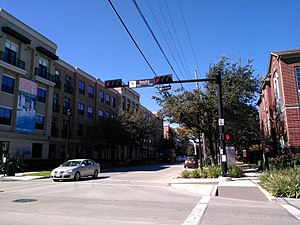Midtown Houston
| Midtown Houston | |
|---|---|
| Neighborhood of Houston | |

Midtown Houston
|
|
| Country |
|
| State |
|
| County | Harris County |
| City |
|
| Population (2010) | |
| • Total | 70,846 |
| • Density | 57,424/sq mi (22,172/km2) |
| Time zone | CST (UTC-6) |
| • Summer (DST) | CDT (UTC-5) |
| ZIP codes | 77002, 77004, 77006 |
| Area code(s) | 713, 281, 832 |
| Website | houstonmidtown.com |
Midtown is a district southwest of Downtown Houston, bordered by Neartown, Interstate 69/U.S. Highway 59 and Interstate 45.
Around 1906 what is now Midtown was divided between the Third Ward and Fourth Ward. Before the 1950s what is now Midtown was a popular residential district. Increasingly, commercial development lead homeowners to leave for neighborhoods they considered less busy. The area became a group of small apartment complexes, low-rise commercial buildings, and older houses. According to a City of Houston report, the remaining churches and the Houston Community College System Central campuses provided the neighborhood's "only stability."
In the 1970s, Midtown became home to Little Saigon, a neighborhood of Vietnamese and Vietnamese Americans, who pioneered the redevelopment of Midtown Houston. During the 1980s, Travis and Milam Streets were viewed as a mirror image of 1970s era Saigon. The Vietnamese areas were established around Milam Street, Webster Street, Fannin Street, and San Jacinto Street. By 1991 this Little Saigon had Vietnamese restaurants, hair salons, car shops, and travel agencies. Mimi Swartz of Texas Monthly stated in 1991 that "Little Saigon is a place to begin easing into a new country".
On June 24, 1994 Isabella Court at 3909-3917 South Main Street received listing in the National Register of Historic Places.
The City of Houston established the Midtown Tax Increment Reinvestment Zone (TIRZ) in 1995. The establishment of the TIRZ lead to the opening of upper income townhomes and apartment complexes in western Midtown and the area along Elizabeth Baldwin Park. Between 1990 and 2000 the area within the Midtown Superneighborhood saw the population increase from 3,070 to 5,311. The increase by 2,241 people was 73% of the 1990 population. During that period about 2,200 multi-family units opened, particularly along Louisiana Street and West Gray Street. Since the total multi-family acreage remained at a small number, the population increase also increased the density of the area. During the 1990s commercial uses increased, particularly along Main Street and Louisiana Street. In 1999 the 76th Texas Legislature created the Midtown Management District.
...
Wikipedia
